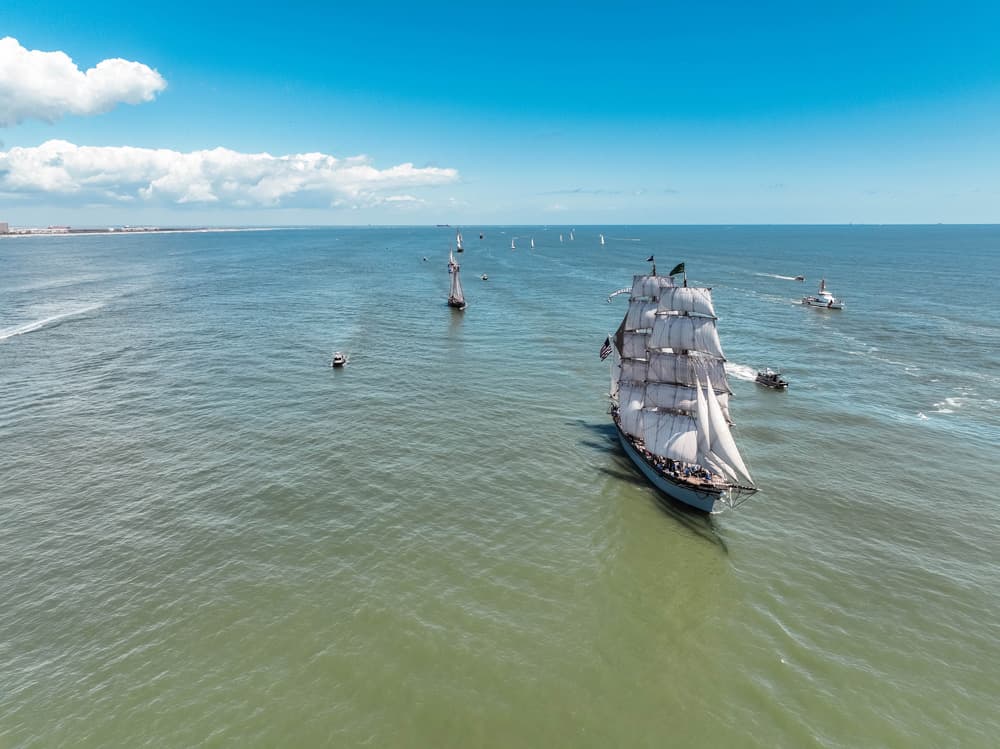Professors Help Bring History to Life
Tweet
By Taylor Bounds, Content Specialist
In April, the Galveston Historical Foundation (GHF), home to the 1877 Elissa, a square-rigged iron barque, welcomed a fleet of tall ships as they made their way across the Gulf of Mexico as part of Tall Ships America. Two professors at Texas A&M University at Galveston, Captain John Peterlin, Assistant Professor of the Practice in the Department of Maritime Transportation and Laura White, Instructional Associate Professor and Scientific Diving Safety Officer in the Department of Liberal Studies served in critical roles for the event.
White and Peterlin teamed up as port liaisons for the Ernestina Morrissey, a 19th century schooner, that according to White is “Absolutely beautiful.” Massachusetts Maritime Academy uses the Ernestina Morrissey for sail and leadership training for cadets and community outreach as the official vessel of the Commonwealth of Massachusetts. The Texas A&M Maritime Academy at the Galveston campus has long had ship-sharing agreements with the other state maritime academies to meet the needs of the maritime industry, and, after successful legislative efforts in Washington, D.C., secured the transfer of the TS Kennedy from Massachusetts Maritime Academy this year and a new, state-of-the-art National Security Multi-Mission Vessel, NSMV Lone Star State, to arrive in 2025.
As port liaisons, their team was responsible for welcoming the Ernestina Morrissey and making sure that the crew had everything they needed to make their stay in Galveston comfortable. “We greeted the crew upon arrival and assisted with hookups for fresh water, power, trash disposal, and other port resources,” said White. “Then, throughout the weekend, we served as an emergency contact, we made grocery and hardware runs, and we worked to direct the crew to various facilities around the island for services like laundry, mail, transportation, and so on!”
At Texas A&M University at Galveston, student coursework includes classes that immerse them in the history of the maritime industry. Through Historic Seafaring and Maritime Heritage (MAST 270), students focus on both technical and cultural topics central to the unique experience of historical bluewater sailors. Students learn about rigging, ship construction and ship outfitting, death and remembrance at sea, sailors' diets and health and diversions and comforts on board. White told bldg. 311 that she and her co-instructor, Ms. Kristin Josvoll, designed the curriculum “to make it as hands-on as possible.”
“In addition to visiting Elissa over the course of the term, we rig a gaff-rigged sloop from the deck up, we have a traditional sailor's potluck in which students prepare and share historic recipes, we listen to shanties, we read and respond to first-hand accounts of historic seafaring, and we visit the local cemeteries to find evidence of symbols of maritime identity on 19th century gravestones,” said White. “At the end of term, students are expected to share a ‘culture and craft' presentation, in which they teach some element of maritime folklore or craftsmanship to their colleagues.” White says for this immersive class, “our goal is for students to try to understand the unique technical and cultural topics driving the perspective of a historic bluewater sailor and to reflect on the role that such sailors had in crafting a modern globalized world.”
Though Peterlin said it had been some time since he had volunteered with GHF, he has been involved with the Elissa since 2007 as a volunteer and as an instructor, and with of tall ship experience spanning 40 years, the professor couldn't pass up the chance to work with Tall Ships Galveston. His first experience with a tall ship was in 1977, when the city of Baltimore was building the Baltimore Clipper Topsail Schooner Pride of Baltimore. He assisted with the rigging and was invited to join the crew for its maiden voyages. The Pride of Baltimore II, whose namesake sank in 1986, was part of Tall Ships Galveston. Peterlin joined the tall ship’s crew for two days sailing in the Gulf of Mexico.
Peterlin, who teaches a course in maritime meteorology, says that being on a vessel controlled by sail forces more situational awareness. “The majority of the earth is covered by water, and it’s that water that creates the opportunity for us to do what we do.”
“I think anyone who is planning to be a deck officer should spend time on a sailing ship,” said Peterlin. “Just get out on the water and get in touch with the elements.”
###
Media contact:More:
Read more about Arts & Humanities
Read more about Business, Law & Society
Read more about Science & Technology
Read more about Liberal Studies
Read more about Maritime Transportation
Read more about Texas A&M Maritime Academy
Read more about Student Life